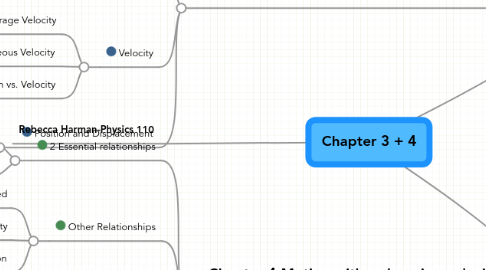
1. Chapter 3-Acceleration and Newton's 2nd Law
1.1. Newton's 2nd law-Acceleration
1.1.1. Acceleration=rate of change of velocity
1.1.2. Velocity=rate of change of position
1.1.3. SI units
1.1.3.1. Force=N
1.1.3.2. Acceleration=m/s2
1.1.4. Average Acceleration
1.1.4.1. Change in velocity/Change in time
1.1.5. Instantaneous Acceleration
1.1.5.1. Limit of Change in velocity/Change in time
1.2. Velocity
1.2.1. Average Velocity
1.2.1.1. Change in positon/change in time
1.2.2. Instantaneous Velocity
1.2.2.1. Limit of change in positon/change in time
1.2.3. Position vs. Velocity
1.2.3.1. rise/run
1.3. Position and Displacement
1.3.1. Position=Direction+Distance
1.3.1.1. Origin=reference point
1.3.2. Displacement=Change of position vector
1.3.2.1. final position vector-initial postion vector
2. Chapter 4-Motion with a changing velocity
2.1. 2 Essential relationships
2.1.1. Change in velocity over a period of time= acceleration x elapsed time
2.1.2. Average Velocity=1/2(final+initial velocity)x change in time
2.2. Other Relationships
2.2.1. -Velocity with a +Acceleration=Decreasing Speed
2.2.2. +Acceleration=Increasing velocity
2.2.3. Increase in speed=positive velocity and acceleration
2.3. Motion Diagram
2.3.1. Shows the positon of an object at certain time intervals
2.4. Free Fall
2.4.1. Apparent weight=0
2.4.2. Acceleration=9.8m/s^2
2.5. Measurements:
2.5.1. Sum of forces: N+mg=ma
2.5.2. Angle of elevation
2.5.2.1. angle of initial velocity above horizontal
